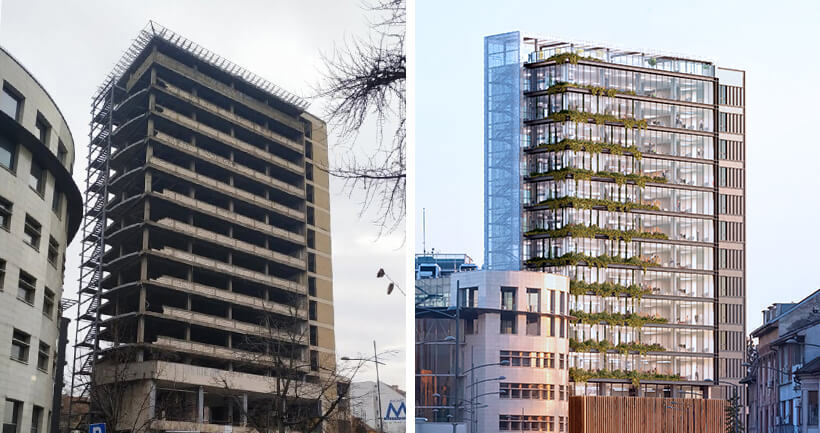How tech and corporate responsibility can fight climate change

The last decade was the warmest in recorded history. The global sea levels are rising at an alarming rate of 3.3 millimeters per year, reminding us that climate change is not a distant threat. On the contrary, it’s a very real and urgent problem that we need to address today.
We’ve been experiencing extreme weather events, biodiversity loss, sea-level rise, and public health crises due to climate change. Scientists agree that the world must rapidly reduce greenhouse gas emissions and limit global warming to 1.5°C before it’s too late.
The first step? Halving emissions until 2030.
The good news is that we can leverage technology and corporate responsibility to fight this serious issue and create a more sustainable future.
World leaders are taking action
Let’s take a look at two important world initiatives that have mapped out key action points for halving emissions.
Race to Zero
In 2021, the United Nations Framework Convention on Climate Change (UNFCCC) launched a campaign called Race to Zero. The goal? Motivating key stakeholders to reach net-zero emissions by 2050 and accelerating the process of transitioning to a low-carbon economy.
So, why is Race to Zero important?
- The world needs to go toward a low-carbon future. The campaign urges businesses and governments to combat climate change and commit to reducing their carbon footprint by pledging to net-zero emissions.
- The Race to Zero contributes to leveling the playing field for businesses and organizations. The program ensures that everyone involved is working toward the same goal by establishing a shared aim of achieving net-zero emissions. As a result, businesses are motivated to come up with creative solutions to lower their emissions and improve their efficiency, which promotes a more competitive atmosphere.
- Lastly, Race to Zero fosters collaboration between key stakeholders and encourages the exchange of ideas. This can help to drive innovation and create new opportunities for sustainable growth
The Exponential Roadmap
Three years before the Race to Zero campaign has seen the light of day, a science-based cross-sector collaboration Exponential Roadmap was launched. It highlights 36 solutions for halving global greenhouse gas emissions by 2030. The roadmap shows how to build a stronger, more resilient, and future-proof global economy and increase human prosperity and health – within the planetary boundaries.
The Exponential Roadmap focuses on the main pollutants, but also on ways to stop and revert global carbon emissions.
But how did we go from 2018 to where we are today in 2023?
The last report from March 20, 2023 states that “we’re running out of time but not out of options to address climate change”. The emissions continued to increase, making tackling this problem even bigger.

The good news is that it’s not too late to act if we act quickly. The IPCC shows us that it’s possible to limit global warming to 1.5°C with rapid and deep emissions reductions across all industries. Its value reflects in offering many effective and low-cost mitigation and adaptation options that governments around the world can use.
The Exponential Roadmap recognizes that the transition to a net-zero economy is necessary. As a matter of fact, creating a sustainable future also means creating new jobs, improving public health, and increasing energy security. All of this should motivate us to do better for the planet.
Identifying the biggest polluters is not a simple task
Identifying the biggest polluters makes sense from a strategic standpoint because it can help us prioritize and act fast to implement policies and reverse the environmental impact made by specific industries.
Alas, it's not that easy to do so because there are many factors at play.
The digital industry
Despite a significant increase in data traffic and mobile subscribers from 2010-2015, emissions and electricity usage in the digital industry declined by 15%. This is due to improved energy efficiency and a shift towards handheld devices.
Still, mainly because of energy consumption, the digital industry is one of the biggest polluters. Electricity still comes from non-renewable sources such as coal and natural gas, and digital devices and data centers use a ton of it.
Then there’s e-waste. Because technology is advancing so quickly, electronic devices become obsolete pretty quickly, and people toss them out. This creates a lot of waste that's bad for the environment and releases emissions as it decomposes.
Also, it’s a well-known fact that manufacturing electronics is not actually environment-friendly. The process requires the extraction of rare earth metals, which can be pretty destructive. And, of course, making things requires energy and generates waste. The logistics of moving electronic devices and components around the world also contribute to emissions. Shipping, air travel, and ground transportation all release emissions.
Finally, we've got internet usage. Streaming video and other digital services require lots of energy and data, which, you guessed it, generates emissions.
Software solutions can help us achieve greater energy efficiency. For example, we can use it to improve the performance of hardware and reduce energy consumption. This can result in significant energy savings in data centers, where a vast amount of energy is used to power and cool servers.
Another way software can help is by supporting the use of renewable energy sources. For example, new-generation wind turbines and solar panels are managed by advanced software. It can also enable demand response, i.e. allow for dynamic management of energy usage based on the availability of renewable energy.
The energy sector
The energy sector is a significant contributor to addressing climate change through various technologies such as solar, wind power, and low-carbon alternatives like nuclear, hydro, and geothermal. Reducing methane emissions is also crucial.
However, methane leaks during fossil fuel extraction and distribution remain a challenge due to low perceived return on investment.
So, what is the role of technology here? What is the positive impact software solutions can have?
Software in energy production and consumption is becoming increasingly important as it enables real-time monitoring of energy, facilitates the integration of renewable energy sources into the power grid, and supports energy efficiency measures.
In particular, the use of data analytics helps optimize energy systems, predict energy demand and supply, and reduce emissions from energy generation and consumption.
The manufacturing industries
Reducing material usage and increasing material efficiency in all industries can lower costs and emissions. Substituting high-emission materials with low-emission alternatives can also lead to significant emission reductions. Just upgrading or replacing equipment with environment-friendly solutions can reduce energy intensity by up to 25% by 2030. Adopting circular business models, such as service-based models, can increase profits and reduce emissions by allowing idle resources to be used by others.
Here's how tech can help in this domain.

Software solutions play a critical role in achieving material efficiency and reducing emissions in industries. For instance, supply chain management software can help track the use of materials and optimize production processes, thereby reducing waste and resource consumption. Digital twins and predictive maintenance software can monitor equipment performance and identify inefficiencies or malfunctions before they lead to breakdowns, reducing downtime and extending equipment lifetimes.
Pretty cool, right?
Transport
Reducing individual ownership of transportation and promoting clean "mobility-as-a-service" offerings can significantly reduce emissions. Electric vehicles emit zero emissions while driving, and cycling or walking are completely emissions-free.
Drivers can help the environment by keeping their cars well-maintained. Small things that seem insignificant such as the type of motor oil or ensuring your tires are properly inflated - actually contribute to reducing the carbon footprint and improving fuel efficiency.
Alternative fuels (e.g. compressed natural gas (CNG), biofuels, hydrogen) that produce less emissions compared to gasoline or diesel are also a part of the solution.
When it comes to the shipping industry - improved routing and new fuel/power-train technologies can reduce emissions in heavy vehicles.
The positive impact different technologies can make here is incredible.
Digital technologies like smart traffic management systems, real-time route optimization, and optimizing mass transit routes lead to improving traffic flow to reduce emissions. Electric vehicles can also benefit from software solutions such as intelligent charging systems, predictive maintenance algorithms, and advanced telematics that optimize driving behavior and route planning.
Finally, virtual meetings are made possible by various software solutions such as video conferencing software, collaboration tools, and project management platforms.
Food consumption
The food industry and agriculture are major contributors to greenhouse gas emissions. Fossil fuels are still used in farming operations and livestock emits around 231 billion pounds of methane into the atmosphere each year. Let’s not forget the fertilizers which contribute to emissions of nitrous oxide, a potent greenhouse gas.

Agriculture is also one of the key players when it comes to deforestation. Deforestation has major implications for biodiversity and carbon sequestration. Just look at this chain reaction: forests are cleared to make way for farmland, the carbon that was stored in the trees gets released into the atmosphere, and there you have it - the greenhouse effect. This is also a water-intensive industry that is jeopardizing aquatic ecosystems.
Technology can effectively solve these problems. Let’s take precision agriculture for example. Sensors, drones, and artificial intelligence can help people optimize farming practices. It’s all about smarter usage of resources and maximizing crop yields. Tech is there to help farmers make better use of their land.
When it comes to food consumption, a healthy plant-based diet can help us reduce emissions and improve our health. The topic of cultured meat is slightly controversial and there are many different perspectives on it, but it can definitely aid in reducing emissions.
What about sustainability in buildings?
Reducing building space demands and investing in low-carbon technologies such as heat pumps, solar cells, and district heating systems can significantly reduce greenhouse gas emissions from buildings. Operational energy use can be lowered by automatically adjusting temperature, ventilation, and lighting.
Additionally, retrofitting buildings with LED lighting, improved insulation, energy-efficient ventilation, and smart windows can have a substantial impact. In cases where new buildings must be constructed, choosing low-carbon materials and products is essential.
Software is playing a significant role in reducing emissions from buildings too. Smart systems can adjust ventilation, temperature, and lighting in real-time based on occupancy and usage patterns. This can help reduce energy waste and costs. Building energy management systems help people monitor energy usage and use the data to optimize building performance.
The example of “Radnicki”
Our company has decided to reconstruct the skeleton of an old building known as "Radnicki" to serve as our new office space. The building has been a painful reminder of a fire that occurred 23 years ago and has remained abandoned since then, despite numerous failed auction attempts due to the substantial reconstruction efforts required.
Although building a new office space could have been a quicker solution, we recognized the importance of considering existing structures. The building's ideal size and location made it the perfect choice for our needs, and we ultimately chose reconstruction over starting from scratch. This action reflects the values we believe in and our commitment to sustainability.

Choosing to reconstruct the old building skeleton for our new office space allowed us to express in multiple ways:
- Giving back to the community by resolving the question of an unused building in the center of the city
- Commitment to carbon zero by prioritizing reuse of existing building space/location and concrete skeleton instead of more construction
- Modernizing the future by using the latest technology by means of safety and sustainability
There were certainly some challenges encountered along the way, but we persevered knowing that the end result would be a one-of-a-kind, customized workspace that would be both functional and visually appealing.
From the moment we announced the reconstruction project, the community response has been overwhelmingly positive, and we look forward to welcoming our employees and visitors to this newly restored space.
What can we do - together and as individuals?
To combat climate change, we need to take action in every sector of the economy including the food sector, electricity, transport, industry, buildings, and land use. It is essential that we support actions, initiatives, products, and companies that are committed to reaching net-zero emissions, as this is the only way to prevent further environmental damage.
As individuals, we can reduce our waste by avoiding single-use products, reusing items as much as possible, and recycling when appropriate. We can also conserve water and use energy-efficient appliances, reduce our carbon footprint by using alternative means of transportation, and eat less meat and dairy while incorporating more plant-based foods.
Collectively, we should advocate for change by supporting policies and practices that promote sustainability, buy products from local businesses that prioritize the environment-first approach, and stay informed about where we’re heading when it comes to climate change.
The crucial role of software
As you’ve seen in the examples written above, technology can help us to monitor and reduce our carbon emissions, improve the efficiency of industrial processes, and optimize the use of renewable energy sources.
As we continue to innovate and develop new solutions in each sector, software development will play a critical role in helping us to achieve our goals of reaching net-zero emissions and building a sustainable future. The second part is that we need solutions fast. With innovation, it always comes down to trial and error, but being able to deliver products fast means rolling out new solutions has to be fast.
When it comes to software development, you should prioritize hiring for technical and domain expertise. Developers with domain experience provide knowledge of these industries, including regulations, best practices, and common challenges. They can identify potential pitfalls, design flaws and security vulnerabilities and implement appropriate measures in the early stage of product development.
How Vega IT can help
As we strive towards a more sustainable future, software vendors must develop a deep understanding of the challenges and opportunities within each sector we mentioned, as well as the technical knowledge to develop effective solutions fast. At Vega IT, we nurture a culture of innovation and partnerships.
We genuinely care about the Race to Zero initiative and the global effort to combat climate change. We know that technology is already playing a vital role in creating innovative solutions that reduce emissions, promote sustainability and educate the masses. We saw that working on numerous projects in recent years that support the same cause.
Now, speed in delivering innovation is what we need. So take a look at our case studies and get familiar with domains we work in, and success stories of our clients. Some of them are right in the pillar sectors for sustainability. Same as you.


